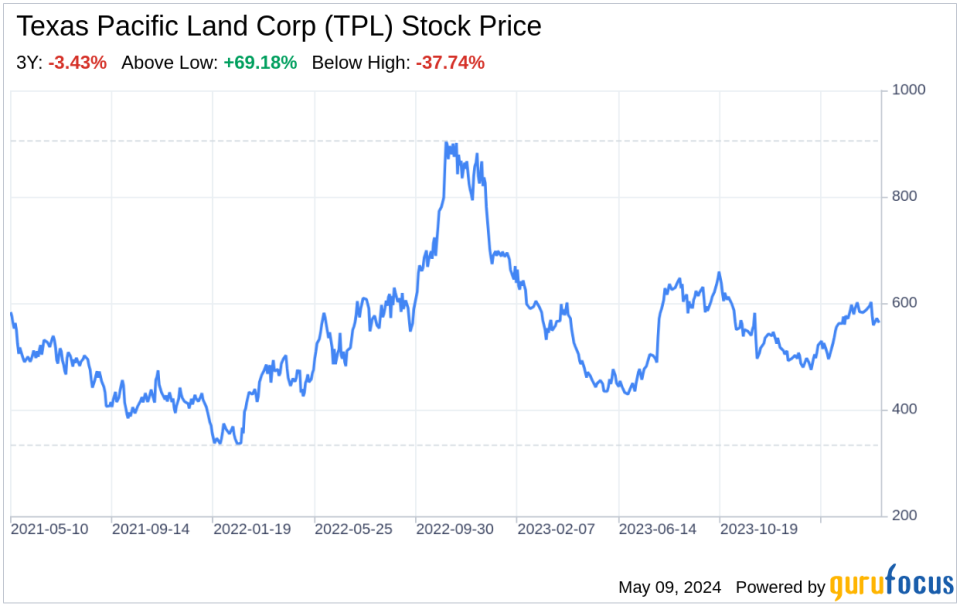Decoding Texas Pacific Land Corp (TPL): A Strategic SWOT Insight
Robust revenue growth driven by increased oil and gas royalties.
Strategic land and resource management bolstering TPL's market position.
Expansion of water services and operations segment to meet industry demand.
Strong balance sheet and liquidity position ensuring resilience against market volatility.
On May 8, 2024, Texas Pacific Land Corp (NYSE:TPL) filed its 10-Q report, providing a detailed account of its financial performance and strategic positioning. As one of the largest landowners in Texas, primarily concentrated in the Permian Basin, TPL's operations span across land and resource management and water services. The company's financial health is robust, with a significant increase in total revenues to $174.1 million for the quarter ended March 31, 2024, compared to $146.4 million for the same period in 2023. This growth is attributed to heightened oil and gas royalties, water sales, and other surface-related income, reflecting TPL's strong operational capabilities and strategic asset utilization.

Strengths
Substantial Land Holdings and Royalty Interests: TPL's extensive land ownership of approximately 868,000 surface acres and approximately 195,000 net royalty acres in the Permian Basin is a formidable asset. This vast land bank not only provides a steady stream of oil and gas royalties but also offers significant leverage in negotiating surface-related income such as easements and commercial leases. The company's recent financials underscore the value of these assets, with oil and gas royalties contributing a substantial portion of the revenue.
Financial Robustness and Liquidity: TPL's financial statements reveal a strong balance sheet with cash and cash equivalents of $837.1 million. The absence of debt enhances TPL's financial stability and provides flexibility to navigate through market fluctuations. The company's ability to fund operations, pay dividends, and repurchase stock without resorting to external financing is a testament to its prudent financial management and operational efficiency.
Weaknesses
Geographic Concentration Risk: While TPL's focus on the Permian Basin has historically been advantageous, it also exposes the company to risks associated with geographic concentration. Any adverse developments in the region, whether regulatory, environmental, or market-related, could disproportionately impact TPL's operations and revenue streams. Diversification of assets across different regions could mitigate this risk.
Dependence on Commodity Prices: TPL's revenue is closely tied to the volatile oil and gas market. Although the company has a strong balance sheet to weather price fluctuations, prolonged periods of low commodity prices could affect royalty income and, consequently, overall profitability. TPL's recent increase in revenues is partly due to favorable oil prices, highlighting this sensitivity.
Opportunities
Expansion of Water Services: The Water Services and Operations segment presents a growth opportunity for TPL, as the demand for water-related services in oil and gas operations continues to rise. By capitalizing on this demand and expanding its full-service water offerings, TPL can diversify its revenue sources and reduce reliance on royalty income. The company's recent investments in water sourcing assets indicate a strategic move in this direction.
Renewable Energy Potential: TPL's land assets offer potential for renewable energy projects, such as solar or wind farms. With the global shift towards sustainable energy, TPL could explore partnerships or ventures to develop renewable energy infrastructure on its land, creating new revenue streams and aligning with environmental goals.
Threats
Regulatory and Environmental Challenges: The oil and gas industry is subject to stringent regulations and increasing environmental scrutiny. Changes in laws or regulations, such as those related to hydraulic fracturing or greenhouse gas emissions, could impose additional costs on TPL's operations or limit its revenue-generating activities. TPL must stay vigilant and adapt to evolving regulatory landscapes to mitigate these risks.
Market Competition and Technological Advancements: TPL operates in a competitive market where technological advancements can rapidly change the industry landscape. Competitors with innovative solutions for water management or land utilization could challenge TPL's market position. Continuous investment in technology and strategic partnerships are essential to maintain a competitive edge.
In conclusion, Texas Pacific Land Corp (NYSE:TPL) exhibits a strong financial and strategic position, underpinned by its extensive land holdings and robust balance sheet. The company's focus on land and resource management, coupled with its expanding water services segment, positions it well to capitalize on opportunities within the Permian Basin. However, TPL must navigate the risks associated with geographic concentration, commodity price dependence, regulatory changes, and market competition. By leveraging its strengths and addressing its weaknesses, TPL can continue to thrive in the dynamic energy sector.
This article, generated by GuruFocus, is designed to provide general insights and is not tailored financial advice. Our commentary is rooted in historical data and analyst projections, utilizing an impartial methodology, and is not intended to serve as specific investment guidance. It does not formulate a recommendation to purchase or divest any stock and does not consider individual investment objectives or financial circumstances. Our objective is to deliver long-term, fundamental data-driven analysis. Be aware that our analysis might not incorporate the most recent, price-sensitive company announcements or qualitative information. GuruFocus holds no position in the stocks mentioned herein.
This article first appeared on GuruFocus.
